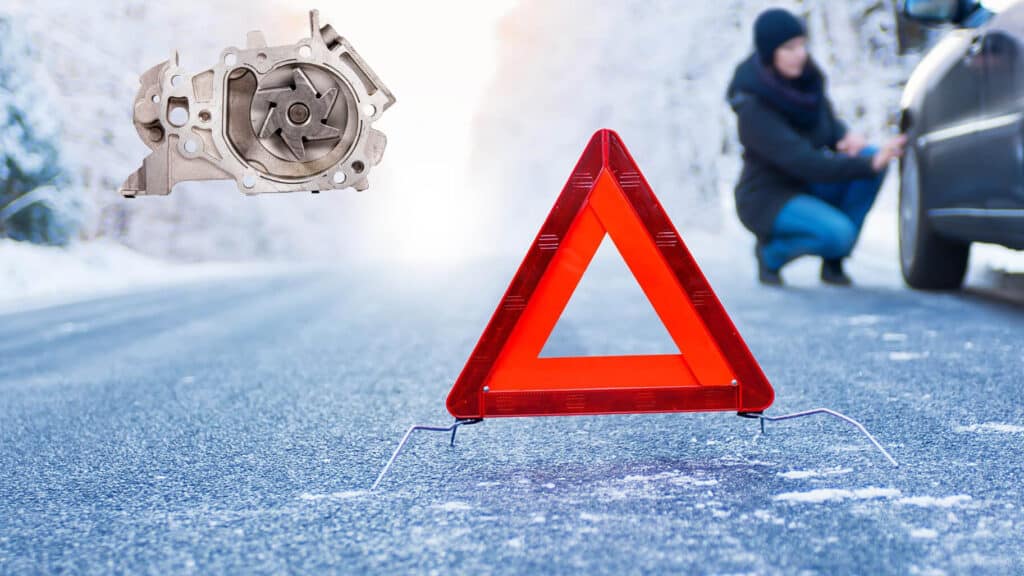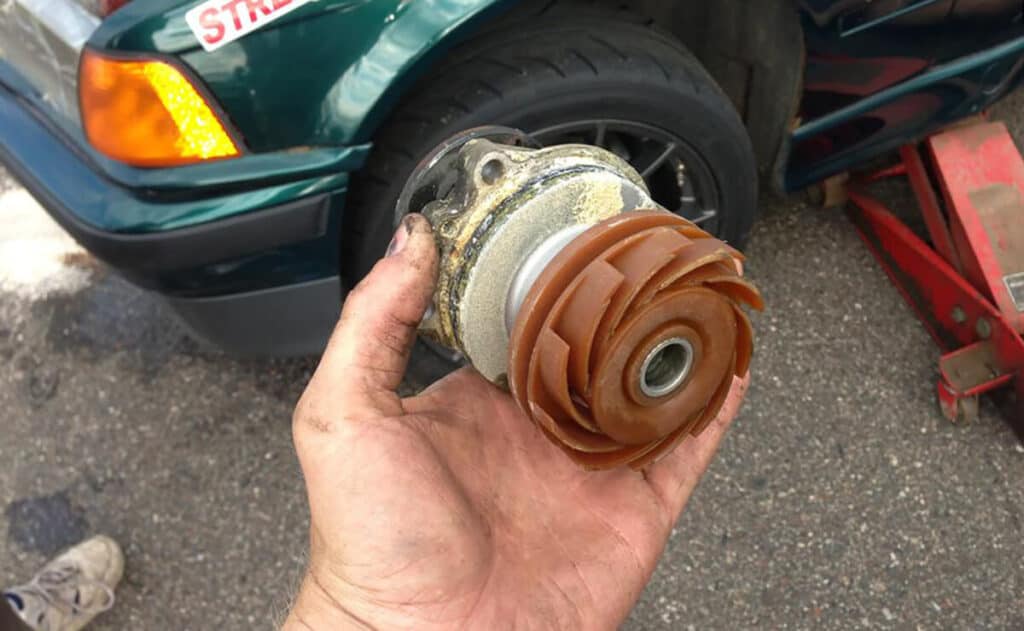Weathering the Extremes – Your Water Pump’s Role
In the vast and varied landscape of Canada, your vehicle’s water pump faces a true test of endurance. From the icy chills of the Yukon to the summer heatwaves of Southern Ontario, each season brings its unique challenges. In this article, we dive into how these extreme weather conditions impact the performance and longevity of your vehicle’s water pump, a critical component in maintaining your engine’s temperature and overall health.
The Cold Truth: Water Pump Challenges in Freezing Temperatures
In the grip of Canada’s winter, the functionality of a vehicle’s water pump can be severely tested. Freezing temperatures can have a profound impact on the coolant, causing it to become more viscous. This increased thickness can impede the flow of coolant through the engine, challenging the pump’s ability to maintain optimal engine temperatures. The cold doesn’t just affect the liquid components; it can also lead to the contraction of metal parts within the pump. This contraction may result in gaps or misalignments, which could become potential sources for leaks or mechanical failures. The risk is particularly high in older vehicles where the water pump and its seals might already be weakened by wear and tear.
As the mercury drops, it’s essential for drivers to be proactive. Ensuring that the coolant mixture is appropriate for cold weather is vital – it should have a suitable antifreeze to water ratio to prevent freezing and maintain fluidity. Additionally, regular winter inspections can identify and address potential issues with the water pump and its components before they lead to a breakdown. This includes checking for leaks, ensuring seals and gaskets are intact, and listening for any unusual noises that might indicate a failing pump.

Summer Heat and Your Pump: Overheating Risks
With the arrival of summer’s high temperatures, the stress on a vehicle’s water pump escalates. The warmer weather can push a water pump to its limits, especially if the cooling system has not been adequately maintained. When exposed to prolonged heat, the engine’s demand for effective cooling increases, placing additional strain on the water pump. This can accelerate the wear and tear of its components, particularly the bearings and seals, which are critical for the pump’s operation. If these components fail, it can lead to coolant leaks or a complete breakdown of the pump, which in turn can cause engine overheating – a serious issue that can lead to costly engine damage.
To mitigate these risks, regular maintenance during the summer months is crucial. This includes checking the coolant level and its condition – ensuring it’s free of contaminants that could hinder its cooling efficiency. The water pump’s drive belt also requires attention; a loose or worn belt can reduce the pump’s effectiveness, leading to overheating. Vehicle owners should also be vigilant for signs of overheating, such as the engine temperature gauge reading higher than usual, or steam emanating from under the hood. In such cases, it’s imperative to stop the vehicle and seek professional assistance to prevent further damage. Summer brings its own set of challenges for water pumps, but with attentive care and maintenance, they can be managed effectively, ensuring your vehicle stays cool under the sun.
Seasonal Shifts: Preparing Your Water Pump for Weather Transitions
1. Inspect for Leaks: As temperatures change, begin by checking around the water pump for any signs of coolant leaks. Look for wet spots or drips under the vehicle or on the pump itself.
2. Check Belt Tension: The belt driving the water pump can expand or contract with temperature fluctuations. Ensure it has the right tension – not too tight or too loose – to maintain efficient pump operation.
3. Verify Coolant Level: Before and after seasonal shifts, check the coolant level in the reservoir. It should be within the recommended range marked on the tank.
4. Examine Coolant Condition: Inspect the coolant’s condition. It should be clear without any rust or debris. Contaminated coolant can reduce the efficiency of your water pump.
5. Test Thermostat Functionality: The thermostat regulates the coolant flow. Ensure it’s working correctly, as a faulty thermostat can lead to overheating or undercooling.
6. Listen for Unusual Noises: Start the engine and listen for any unusual noises from the water pump area. Sounds like whining or grinding can indicate a problem.
7. Consider Professional Inspection: If unsure about any aspect, consider having a professional mechanic inspect the system, especially when transitioning from extreme cold to warmer temperatures.
8. Prepare for Emergency: Keep an emergency kit with coolant, distilled water, and basic tools in your vehicle, especially during major seasonal shifts.
Salt, Rust, and Corrosion: The Hidden Enemies
Battling Winter’s Harshness: Canadian winters are not only challenging for drivers but also for their vehicles, especially when it comes to the water pump. The liberal use of road salt, while essential for safe driving, can be a significant adversary to vehicle parts. This is particularly true for the water pump, where salt exposure can lead to accelerated rusting and corrosion. This degradation is more pronounced in older models or those with more vulnerable metal components. Regular maintenance during these colder months is essential to identify early signs of corrosion and take necessary preventive measures.
Proactive Measures for Protection: To combat the effects of salt, routine cleaning and thorough inspections of the water pump and related components are crucial. This includes checking for any signs of rust or corrosion build-up and ensuring that all seals and gaskets are intact to prevent leaks. For vehicles frequently exposed to salty conditions, more frequent checks may be required. Diligent care and prompt action in addressing any signs of deterioration can significantly extend the life of the water pump and maintain its efficiency.
The Role of Coolant: Protecting Your Pump Year-Round
• Understand Coolant Types: Familiarize yourself with the type of coolant recommended for your vehicle. Different engines may require specific coolant formulations.
• Maintain the Right Mixture: Ensure the coolant is mixed correctly, typically a 50/50 mix of antifreeze and water. This balance is crucial for optimal performance in both hot and cold conditions.
• Check for Freeze Protection: In winter, test the coolant’s freeze protection level using a hydrometer or antifreeze tester to ensure it can withstand the lower temperatures without freezing.
• Monitor Boil-Over Protection: In summer, the coolant should also provide boil-over protection, preventing the engine from overheating.
• Regularly Change Coolant: Follow your vehicle’s maintenance schedule for changing the coolant. Over time, coolant loses its effectiveness and can become acidic, which can damage the water pump and other components.
• Inspect for Corrosion and Deposits: Regularly check for signs of rust or scale deposits in the coolant, as these can indicate corrosion within the system.
• Avoid Mixing Coolants: Do not mix different types of coolants unless they are compatible. Mixing can lead to reduced effectiveness and potential damage.
• Stay Alert to Changes: Pay attention to any changes in engine temperature or performance, as these can indicate issues with the coolant or water pump.

Expert Insights: Professional Advice for Optimal Pump Performance
Leveraging Expert Knowledge: Navigating through the varied Canadian climates requires more than just seasonal adjustments; it calls for expert insights. Professional mechanics bring a wealth of experience and specialized knowledge that is crucial for maintaining the health of your water pump. Regular inspections by a professional can detect subtle issues that might go unnoticed otherwise. These experts can provide customized maintenance advice, taking into account the specific model of your vehicle, its age, and your typical driving patterns.
Tailored Strategies for Diverse Conditions: Every vehicle and its use case are unique, particularly in a country with weather as diverse as Canada’s. A mechanic’s role extends beyond mere inspections; they offer tailored strategies to ensure that your water pump is adequately prepared for both the freezing winters and scorching summers. They can advise on the best coolant types, replacement schedules, and even offer tips on driving practices to reduce the strain on the water pump. This personalized approach ensures that your vehicle remains reliable, regardless of the weather outside.
Embracing the Elements with Confidence
Understanding the influence of Canadian weather on your water pump is key to maintaining your vehicle’s reliability. By embracing regular maintenance and adapting to seasonal challenges, you can ensure that your water pump, and thus your vehicle, operates smoothly throughout the year. And for those moments when you need expert assistance, Uchanics is here to provide professional, convenient mobile mechanic services, ensuring your vehicle braves the Canadian elements with confidence.
